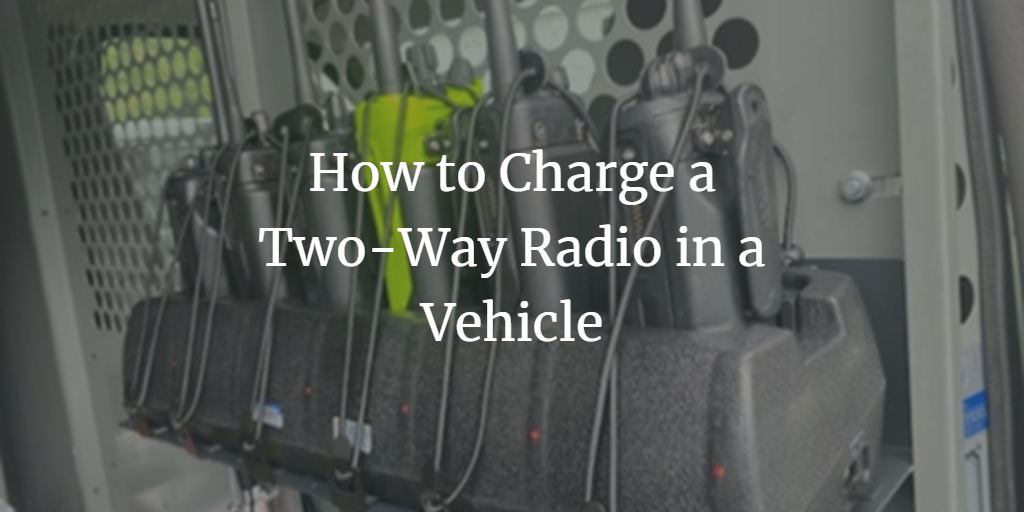Charging a two-way radio can be difficult when you’re on the road. If you’re always on the go or away from the office, you need something that will charge a dying battery so you can stay connected. Portable radio in-vehicle chargers accomplish just that. Mounted inside your vehicle, it’s the perfect solution for charging your radio on the go.
In this article, we’ll talk about how in-vehicle chargers work and the reasons for using one in your car.
- Who Are They For?
- How it Works
- Best Placement
- Advantages
Who Are They For?
Radio users of all sorts can benefit from an in-vehicle charger. While in this article, we’ll mostly be talking about professional portable two-way radios, in-vehicle chargers can still benefit a wide range of industries, no matter the type of radio. Here are some popular industries that use in-vehicle chargers for their fleet of radios.
- Commercial
- Public Safety: Law Enforcement, Fire, EMS, etc.
- Security
- Forestry
- Emergency Rescue
- Border Patrol
How It Works
In-vehicle chargers run off the power from your car either by a vehicle power adapter (cigarette lighter) or hardwired to the car’s battery. These chargers will come with a mounting bracket that mounts to the inside of your vehicle, typically on the dash or floor.
In-vehicle chargers that use a vehicle power adapter will usually be in a single station (charging one radio/battery at a time) style but could also be hardwired if needed. Other larger bank chargers like a 6 bank or 12 bank, even dual bank, will usually be hardwired to the car’s battery because they require more power to operate than a standard 12V outlet output.
In some cases, like with low-powered walkie-talkies or Push to Talk over Cellular devices, an in-vehicle charger can charge via USB but with public safety portable radios, USB charging is not typical because they require more power to charge.
Since the charger runs off the car’s power or battery, the charger will stop charging when the vehicle is turned off. Hardwiring your charger to your car's battery should have no effect on the performance of the battery over time.

Best Placement for Portable Radio In-Vehicle Chargers
The best placement for an in-vehicle charger is going to be what’s most convenient for you. It should be in a place that is easily accessible for you to get to. In most cases, these chargers will be mounted on the floor, dash, or center console. Another possible placement, especially for larger chargers, would be on a van bulkhead (pictured below) or a trunk.

Advantages of In-Vehicle Chargers
Let’s talk about the pros of using an in-vehicle charger.
- Compact
- Holds Radio Secure
- Great for Natural Disasters
- Convenient
- Radio Stays Powered
1. Compact
Most in-vehicle chargers are designed to be space efficient and don’t take up too much room. This is especially important inside police vehicles, where space is limited.
2. Holds Radio Secure
Sharp turns and bumpy roads won’t make your portable radio fall off the charger. In-vehicle chargers typically come with tie-down straps that go over the radio to securely hug it in place while driving.

3. Great to Have During Natural Disasters and Emergencies
Hurricanes and other natural disasters can knock power out for long times, and during clean-up and rescue, it’s important to keep your two-way radio charged. Because in-vehicle charges only require the power from your vehicle to charge, it makes them the best option for recharging your fleet during emergencies.
4. Convenient
If your battery is dying while on the road, you have the convenience to charge while on the go. This way you’re less likely to be left without communication.
5. Radio Stays Powered
Your two-way radio can stay powered on while sitting on an in-vehicle charger. When you still need to listen or respond to radio communication when charging, you’re able to.
How We Can Help
Waveband Communications in-vehicle chargers charge most major two-way radio models including Motorola, Kenwood, Harris, BK Technologies, and ICOM, and can charge Ni-MH, Ni-Cd, and lithium-based battery chemistries. Waveband Communications can help you stay charged while on the go.



